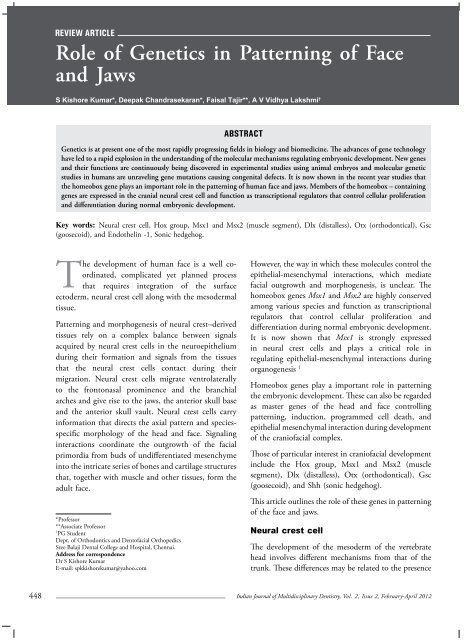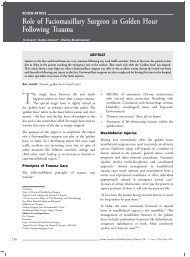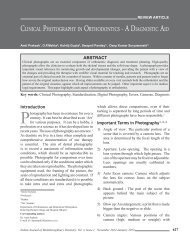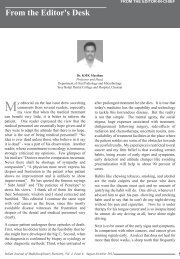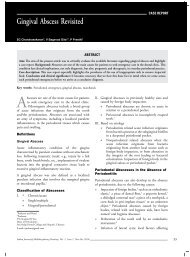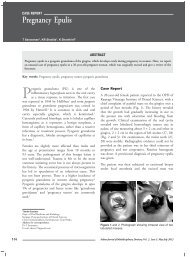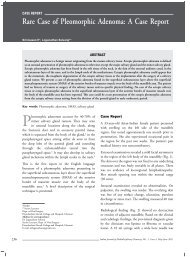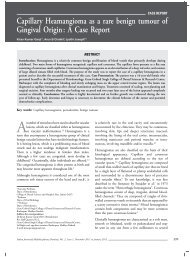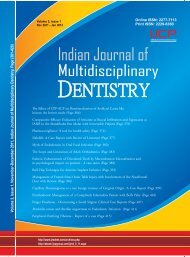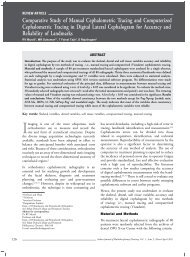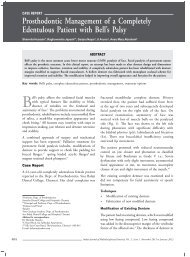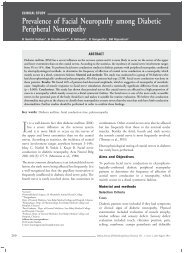Review articleRole of Genetics in Patterning of Faceand JawsS Kishore Kumar*, Deepak Chandrasekaran*, Faisal Tajir**, A V Vidhya Lakshmi †AbstractGenetics is at present one of the most rapidly progressing fields in biology and biomedicine. The advances of gene technologyhave led to a rapid explosion in the understanding of the molecular mechanisms regulating embryonic development. New genesand their functions are continuously being discovered in experimental studies using animal embryos and molecular geneticstudies in humans are unraveling gene mutations causing congenital defects. It is now shown in the recent year studies thatthe homeobox gene plays an important role in the patterning of human face and jaws. Members of the homeobox – containinggenes are expressed in the cranial neural crest cell and function as transcriptional regulators that control cellular proliferationand differentiation during normal embryonic development.Key words: Neural crest cell, Hox group, Msx1 and Msx2 (muscle segment), Dlx (distalless), Otx (orthodontical), Gsc(goosecoid), and Endothelin -1, Sonic hedgehog.The development of human face is a well coordinated,complicated yet planned processthat requires integration of the surfaceectoderm, neural crest cell along with the mesodermaltissue.Patterning and morphogenesis of neural crest–derivedtissues rely on a complex balance between signalsacquired by neural crest cells in the neuroepitheliumduring their formation and signals from the tissuesthat the neural crest cells contact during theirmigration. Neural crest cells migrate ventrolaterallyto the frontonasal prominence and the branchialarches and give rise to the jaws, the anterior skull baseand the anterior skull vault. Neural crest cells carryinformation that directs the axial pattern and speciesspecificmorphology of the head and face. Signalinginteractions coordinate the outgrowth of the facialprimordia from buds of undifferentiated mesenchymeinto the intricate series of bones and cartilage structuresthat, together with muscle and other tissues, form theadult face.*Professor**Associate Professor†PG StudentDept. of Orthodontics and Dentofacial OrthopedicsSree Balaji Dental College and Hospital, Chennai.Address for correspondenceDr S Kishore KumarE-mail: spkkishorekumar@yahoo.comHowever, the way in which these molecules control theepithelial-mesenchymal interactions, which mediatefacial outgrowth and morphogenesis, is unclear. Thehomeobox genes Msx1 and Msx2 are highly conservedamong various species and function as transcriptionalregulators that control cellular proliferation anddifferentiation during normal embryonic development.It is now shown that Msx1 is strongly expressedin neural crest cells and plays a critical role inregulating epithelial-mesenchymal interactions duringorganogenesis 1Homeobox genes play a important role in patterningthe embryonic development. These can also be regardedas master genes of the head and face controllingpatterning, induction, programmed cell death, andepithelial mesenchymal interaction during developmentof the craniofacial complex.Those of particular interest in craniofacial developmentinclude the Hox group, Msx1 and Msx2 (musclesegment), Dlx (distalless), Otx (orthodontical), Gsc(goosecoid), and Shh (sonic hedgehog).This article outlines the role of these genes in patterningof the face and jaws.Neural crest cellThe development of the mesoderm of the vertebratehead involves different mechanisms from that of thetrunk. These differences may be related to the presence448Indian Journal of Multidisciplinary Dentistry, Vol. 2, <strong>Issue</strong> 2, February-April 2012
Review Articleof a tissue, the neural crest, which is able to undertakeroles that in the rest of the body are played by theparaxial mesoderm. Neural crest cells originate fromthe boundary between the neural plate and the surfaceectoderm. The crest migrates ventrally and in thehindbrain region of all vertebrates populates a seriesof repeating structures, the branchial arches. 2 In thetrunk, there are subpopulations of crest that followdifferent temporal and spatial migration pathways,and it is possible that, in the head, there are differentpopulations as well. The early migrating cells in the headreach the branchial arches and adopt a mesenchymalfate, while later emerging cells remain closer to theneural tube and adopt a neural fate. 3Interactions with head epithelia such as the neuraltube and surface ectoderm seem to be important inneural crest differentiation and some aspects of headmorphogenesis in chick. 4 However, evidence suggeststhat while the neural crest is extensively dependenton surrounding tissue to allow differentiation, somepatterning information resides within the CTest itself.This has been shown in experiments where sectionsof chick midbrain neural plate, whose crest normallycolonises the first (maxillary and mandibular) arch,have been grafted to the second (hyoid) arch level. 5 Theneural crest migrated into the hyoid arch, but thereformed mandibles, which are first arch structures. Inaddition, these ectopic mandibles had a set of musclesattached to them that were derived from the secondarch paraxial mesoderm, but resembled first archmuscles. Duplicate beaks were also formed on thesurface, suggesting that the differentiation pattern ofsecond arch paraxial mesoderm and surface ectodermwas controlled by the neural crest.Homeobox geneMuch recent work has centred on the isolation offamilies of transcription factors potentially involved inearly developmental decisions such as establishing thebasic body plan.In humans a number of other homeobox-containinggenes are expressed in the maxillary and mandibulararches, and developing facial primoridia. Thesegenes, which all encode homeodomain–containingtranscription factors, include Msx-1, Msx-2, Dlx1-6and Barx-1. Again many of these homeobox-containinggenes are related to the families of gene found inDrosophila. Knockout studies have confirmed thatthese genes perform essential roles during the formationof the facial complex.Members of the Msx gene family (Msx-1 and Msx-2) arenormally expressed strongly in the neural crest derivedmesenchyme of the developing facial prominence, andthere is now strong evidence for a role of these genesin specification of the skull and face. 2Targeted disruption of Msx-1 in the mouse producesa number of defects in facial structures. There is cleftpalate associated with a loss of the palatine bones,maxillary and mandibular hypoplasia, and a highlypenetrant arrest of tooth formation at the bud stage oftooth development. 3In mice, defects in Msx-2 cause skull ossification withpersistence of calvarial foramen. This arises as a result ofdefective osteoprogenitor proliferation during calvarialmorphogenesis. 4Members of the multi-gene Dlx family are expressedin a complex pattern within the embryonic ectodermand mesenchyme of the maxillary and mandibularprocesses of the first arch. 5Targeted mutation in Dlx-1, Dlx-2 and Dlx 1/2provide evidence that these genes are required forthe development of neural crest derived skeletalelements of the first and second branchial arches. 6Analysis of these mutations reveals that Dlx-1 andDlx-2 regulate proximal first arch structures and that,in the mandibular primordium, there is considerablefunctional redundancy of Dlx-1 and Dlx-2 with othermembers of the Dlx family.Goosecoid GeneGoosecoid is another homeobox-containingtranscription factor, originally isolated in Xenopusfrom a dorsal blastopore lip cDNA library. The dorsalblastopore lip has long been known to be ultimatelyresponsible for organization of the complete body axisin the early embryo. However, when goosecoid wasknocked out in transgenic mice they formed a bodyaxis normally, but exhibited a number of craniofacialdefects. 7In wild type mice, goosecoid transcripts had beendetected at later stages of development in the osteogenicIndian Journal of Multidisciplinary Dentistry, Vol. 2, <strong>Issue</strong> 2, February-April 2012449


